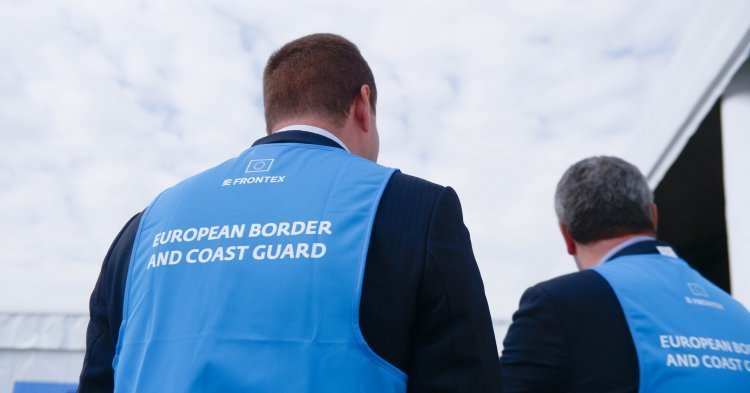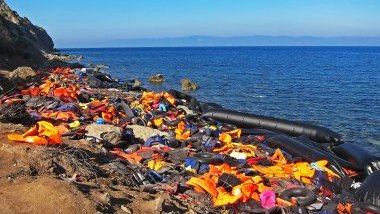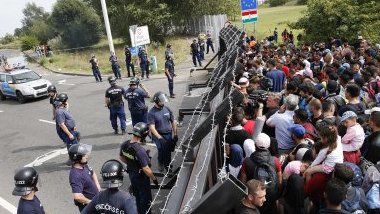Frontex renewal
Following the refugee crisis in 2015, the European Union decided to reinforce the control of its external borders. Frontex transformed into a European Border and Coast Guard Agency in 2016. Changes will operate regarding both human and material means of Frontex, as well as regarding its power of execution.
Frontex, indeed, was relying on the European states’ air and naval teams and means. It ensured that the national services in charge of external borders control cooperate among themselves. The agency’s name change should reflect the evolution of its mandate. The objective was to reinforce it at the human level, for it to possess its own equipment, and above all to support the neighbouring third countries, which have to manage an important inflow of migrants. From 2016, a reserve pool of 1,500 guards was established for a quick deployment in case of crisis or emergency. In 2018, the European Council wanted the European Border and Coast Guard to be reinforced. The Commission thus drew a proposal in that sense.
10,000 border guards by 2027
In his State of the Union 2018, Jean-Claude Juncker announced 10,000 border guards by 2020. This European guard will be composed of the agency’s personnel and of the member states’ seconded personnel for both long term and short term. The Commission’s objective is that the agency’s permanent agents and the seconded personnel both increase compared to the number of deployed agents. The agency will have its own naval, air and land equipment. The amount of these propositions reaches 11.3 million euros for the 2021-2027 multiannual budget.
The European guard will be able to operate at the EU’s external borders to check identities and arrest irregular migrants. It will be able to operate in non-European countries during joint operations. This team will keep supporting the member states regarding the returns, and will have to make them more efficient. It will also have to cooperate with the European Asylum Support Office, especially in the hotspots (registration centres).
Even if this new contingent will be more autonomous regarding the human, material and operational means, their interventions will be still supervised by the hosting member state, which remains in control of its borders. In February 2019, the Council postponed the Commission’s objective of having 10,000 border guards by 2027. The contingent’s deployment should start on 1st January 2021. A first examination of the Commission should happen in June 2023. It will enable to evaluate if bringing modifications on the contingent’s size or composition is necessary. The European Parliament expressed in favour of the proposition on 17 April 2019.
Saving Schengen before saving the migrants?
Schengen’s objective was to create a space without internal borders. But to reach this goal while ensuring a high level of security within the EU, one should have thought about protecting our external borders as well, and to agree on who could enter this space. Working on the basis that we do not have one common external border, but external borders, introducing mutual trust between the member states was necessary.
After the 2015 crisis, where are the fundamental principles of the Schengen area? Still today, the member states struggle to agree on the distribution of the people who crossed the Mediterranean Sea, and Greece for example had difficulties to control its coasts. The Schengen area has not stopped being called into question. In front of these threats, the European states decided to respond to the need to protect our area, rather than to the need to save those who attempt to cross the Mediterranean.
This last mission does not appear in the Commission’s proposal. And yet, rethinking the rescue of those who cross the Mediterranean is today crucial.
The EU developed several missions at sea: the Operation Themis in Italian and Maltese waters, the Operation Poseidon in Greek waters, and the Operations Minerva and Indalo in Spanish waters. The Operation Sophia, targeting Libya, was prolonged until 30 September 2019, with the suspension of the naval deployment and the continuity of the air deployment.
The Libya coast guards will thus be in charge of the naval deployment on their maritime area. However, the situation in Libya is tensed: clashes have been occurring in the south of Tripoli between the Marechal Khalifa Haftar and the government of Fayez- Al-Sarraj. In front of these tensions which could lead to a new migration wave, the EU will soon have its new border and coast guards to protect its borders.
But when one carefully thinks about it, can Schengen really be saved if advances are only made on our “house” security, without addressing the issue of those who attempt to join it? The rescue of migrants on sea and their treatment on the European territory remains a sensitive question for the European states, especially within the current populist atmosphere, both before and after the European elections…








Follow the comments: |
|
